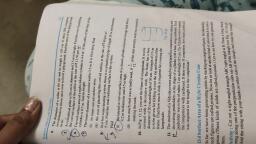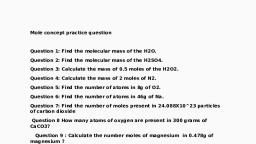Question 1 :
The unit of energy and work
called joule, is named after James Prescott Joule.
Question 2 :
Certain force acting on a 20 kg mass changes its velocity from 5 $\frac{m}{s}$to 2 $\frac{m}{s}$. Calculate the work done by the force.
Question 4 :
According to the law of conservation of energy, energy can only be transformed from one form to another; it can neither be created nor destroyed. The total energy before and after the transformation always remains constant.
Question 5 :
A pair of bullocks exerts a force of 140 N on a plough. The field being ploughed is 15 m long. How much work is done in ploughing the length of the field?
Question 6 :
Avinash can run with a speed of $8 ms^{-1}$ against the frictional force of 10 N, and Kapil can move with a speed of $3 ms^{–1}$ against the frictional force of 25 N. Who is more powerful and why?
Question 8 :
The sum of the potential energy and kinetic energy of the object would be the same at all points. That is, potential energy + kinetic energy = constant.
Question 9 :
Is it possible that an object is in the state of accelerated motion due to external force acting on it, but no work is being done by the force.
Question 10 :
Two girls, each of weight 400 N climb up a rope through a height of 8 m. We name one of the girls A and the other B. Girl A takes 20 s while B takes 50 s to accomplish this task. What is the power expended by each girl?
Question 11 :
In case of negative work the angle between the force and displacement is
Question 13 :
Work done on an object is defined as the magnitude of the force multiplied by the distance moved by the object in the direction of the applied force. The unit of work is joule:$ 1 joule = 1 newton \times 1 metre.$ Is the statement true or false?
Question 14 :
A person holds a bundle of hay over his head for 30 minutes and gets tired. Has he done some work or not?
Question 15 :
The energy possessed by a body due to its change in position or shape is called the potential energy.
Question 16 :
The energy used in one hour at the rate of 1kW is called 1 kW h. TRUE OR FALSE?
Question 17 :
Which one of the following is not the unit of energy?
Question 18 :
The energy used in one hour at the rate of 1kW is called 1 kW h.
Question 19 :
A mass of 10 kg is at a point A on a table. It is moved to a point B. If the line joining A and B is horizontal, what is the work done on the object by the gravitational force?
Question 20 :
A lamp consumes 1000 J of electrical energy in 10 s. What is its power?
Question 21 :
Soni says that the acceleration in an object could be zero even when several forces are acting on it. Do you agree with her?
Question 22 :
The work done on an object does not depend upon the
Question 23 :
The relation connecting the initial velocity $\left(u\right)$ and final velocity $\left(v\right)$ of an object moving with a uniform acceleration a, and the displacement, s is__________.
Question 24 :
The kinetic energy of an object of mass, m moving with a velocity of 5 m $s^{-1}$ is 25 J. What will be its kinetic energy when its velocity is doubled? What will be its kinetic energy when its velocity is increased three times?
Question 25 :
An electric heater is rated 1500 W. How much energy does it use in 10 hours?
Question 26 :
Find the energy in kW h consumed in 10 hours by four devices of power 500 W each.
Question 27 :
An object in motion possesses what is known as the kinetic energy of the object.
Question 28 :
Calculate the work required to be done to stop a car of 1500 kg moving at a velocity of 60 $\frac{km}{h}$.
Question 29 :
An object having capability to do work is said to possess energy. Energy has the same unit as that of work.
Question 30 :
A car is accelerated on a levelled road and attains a velocity 4 times of its initial velocity. In this process the potential energy of the car
Question 31 :
<img style='object-fit:contain' src='https://teachmint.storage.googleapis.com/question_assets/cbse_ncert/61b1d2b5f59b460d7261f610.JPG' />
In the given figure, a boy is moving on a straight road against a frictional force of 5 N. After travelling a distance of 1.5 km he forgot the correct path at a round about of radius 100m. However, he moves on the circular path for one and half cycle and then he moves forward upto 2.0 km. Calculate the work done by him.
Question 32 :
A 150 kg car engine develops 500 W for each kg. What force does it exert in moving the car at a speed of $20 ms^{–1}?$
Question 33 :
Calculate the work required to be done to stop a car of 1500 kg moving at a velocity of 60 km/h?
Question 34 :
A sailboat is moving due to wind energy. Is it a work?
Question 35 :
An object thrown at a certain angle to the ground moves in a curved path and falls back to the ground. The initial and the final points of the path of the object lie on the same horizontal line. What is the work done by the force of gravity on the object?
Question 36 :
Compare the power at which a butterfly of mass 1.0 g that flies upward at a rate of $0.5 ms^{–1}$ is moving upwards against the force of gravity. $(given g = 10 ms^{–2})$
Question 37 :
If an electric iron of 1200 W is used for 30 minutes everyday, find electric energy consumed in the month of April.
Question 38 :
If the object is starting from its stationary position, that is, u = 0, then work done, W = ?
Question 39 :
A donkey is carrying a load on its back. Is it a work?
Question 40 :
What are the various energy transformations that occur when you are riding a bicycle?





















































